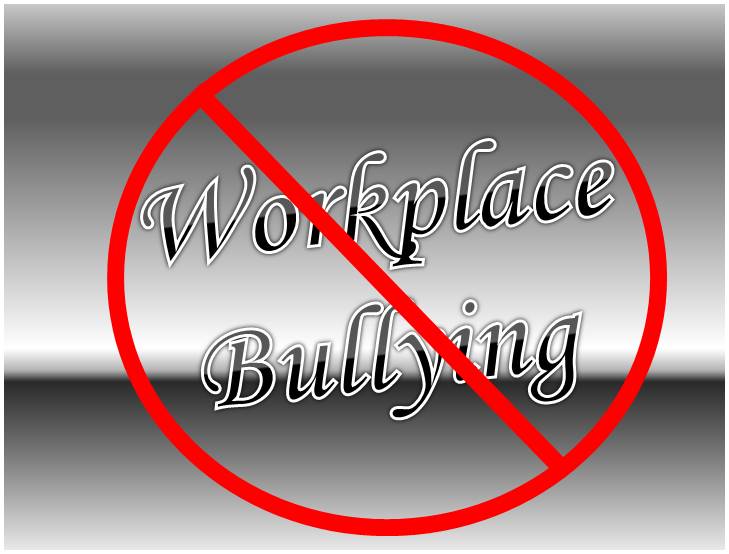Workplace Bullying defined by Workplacebullying.org is — repeated, health-harming mistreatment of one or more persons (the targets) by one or more perpetrators. It can include such tactics as verbal, nonverbal, psychological, physical abuse and humiliation which is meant to sabotage the target (s).
When we hear the term bullying, most of us picture a high school locker room or school bus with emotionally immature kids, where those of a lessor physical or social stature are being preyed upon by predators.
The problem is workplace bullies often operate within the established rules and policies of employer and their society and can be hard to address.. The fact is workplace bullying is four times more common than either sexual harassment or racial discrimination on the job. Forty percent (40%) of targets never even tell their employers. According to business.com 72% of the adult American public is familiar with instances of workplace bullying and another 65.6% are affected by bulling.

Two of the most toxic workplace bullying traits are Transforming Bullies and Character Assassins and often times they escape detection during the hiring process. Workplace bullies will sometimes possess both personalities and or just one, but they will present themselves as being charming and charismatic during the interview process, in an attempt to impresses and sway those that are conducting the interview to hire them.
Transforming Bullies are like the fictional character in the 1931 film Dr. Jekyll and Mr. Hyde. They are quick to establish their status once being hired, as they attempt to weaken other employees’ relationships with the superior. They will attempt to flatter and charm those from whom they seek opportunities or take advantage of, while boasting about their past accomplishments.
They are crafty manipulators driven by only their own success, stepping on all those around them to achieve that desired success. They appear to be team players on the surface when superiors are present, but their sole agenda is to tear down others to make them look good for future advancement. Transforming Bullies’ are usually always confrontational and often times will steal credit from other employees or team members and are quick to embed their claws in their peers and subordinates.
Character Assassin is other personality trait of a workplace bully. They will start a deliberate sustained and aimed process of tarnishing the credibility and reputation of their targets. Many will even launch a covert effort to tarnish their superiors, if it will help them achieve the success they desire. They spin the information with exaggeration, misleading half-truths or just manipulation of facts to present an untrue picture of the targeted person. They ruthlessly defame their targets, repeating questioning and discrediting accomplishments or activities; in an attempt to remove them or neutralize them so that they can achieve power.
As a tool character assassins are quick to engage and share in workplace gossip in an attempt to learn and discredit those they want to target. They act without any regret and relish in the results they achieve, often times bragging about how they got a co-worker reprimanded or even terminated. Their toxic divisiveness soon seeps into the fabric of your place of employment or team, which in turn lessens the team effectiveness and weakens their accomplishment.
Over time Workplace bullies are easy to identify because they have very few friends at work, because co-workers eventually learn to steer clear from them for fear of being targeted. They are easy to detect when you ask them — how they take criticism, or to describe achievements that they and their team have accomplished? Workplace bullies find it difficult to answer these questions. They value their criticism as a bag of pride, and are quick to blame those with low energy for such criticism. They are quick to take credit for motivating others, highlighting only their own achievements instead of the team.
Workplace bullies usually have an extremely high self-esteem of themself and believe that they are more important than the team, and are very prone to display hot and cold relationships with their co-workers. They often times project that their time is more valuable than all those around them.
If you stand up to them they will attempt to get rid of you and will begin to plot against you. But sooner or later, bullies show their true colors and often times will wreak significant collateral damage before you can remove them from your organization.

Once workplace bullies’ tactics are identified and addressed by their employer, many workplace bullies will attempt to take legal action with EEOC, OSHA, Human Resources or start to make threats of lawsuits. Many will hint that they will take clients or customers with them if they leave in an effort to re-establish their value.
As a business owner or manager, you should be concerned with both monetary and non-monetary reasons of a workplace bully. The cost in turnover and retaining, absenteeism, reduction of workplace engagement, loss of revenue earning opportunities and potential litigation costs should be enough to have business owners and managers be concerned.
Workplace Bullies demoralize productive employees and eventually employers become exposed to potential workers compensation claims and liability related claims when the bully eventually crosses the line into discrimination, retaliation or illegal harassment. These claims can become very costly, especially if you don’t have any Employment Practice Liability Insurance, because many of these policies come with a large deductible.
The cost of a workplace bully can dramatically impact an organization’s bottom line and is an unnecessary and preventable loss. Turnover costs caused by a workplace bully alone are rather expense, and are easily figured by multiplying the combined salaries of departed workers by 1.5, which is a very conservative multiplier, according to experts.
To better address this risk here are the Top 6 Tips To Address A Workplace Bullying with your Organizations:
1. Develop and articulate a zero workplace bullying policy or a tolerance policy
2. Document all complaints, violations of company policy, emails or other communications and corrective disciplinary action taken
3. Provide a safe environment to foster open discussion about the issue of workplace bullying
4. Provide leaders and employees with training on how to spot a workplace bully
5. Provide leaders with training on conflict management and provide resources, such as outside facilitators and coaches, to aid in dealing with workplace bullies
6. Be transparent, listen to your employees and do the right thing, not the easy thing
Despite their accomplishments many workplace bullies will have a spotted history of job hopping, because they were eventually exposed and dealt with for their behavior. Many have attempted to sue their past employers and sometimes are very boastful of that fact with others. While other workplace bullies will attempt to keep their past employment hidden to avoid detection of the real reason why they resigned or were terminated.
To be proactive and to avoid hiring a disguised workplace bully, all you need to do is deepen your questioning and reference-checking practices. The deeper you go the more you will peel back that onion, and the less people share about that person, the more you should be concerned. Many potential reference checks understand that if they did share too much they very well could become a target again in the form of a defamation lawsuit, so they will clam up when pressed for more information.
Skilled interviewers should also listen for verbal and non-verbal hints of an aggressive personality. Most will brag about their aggressive stance as a source for their accomplishments, so trust your instincts when you are conducting the interview because the single best way to address a workplace bully is to avoid hiring them.
Be Safe My Friends
Keven Moore works in risk management services. He has a bachelor’s degree from University of Kentucky, a master’s from Eastern Kentucky University and 25-plus years of experience in the safety and insurance profession. He lives in Lexington with his family and works out of both the Lexington and Northern Kentucky offices. Keven can be reached at kmoore@roeding.com.






















